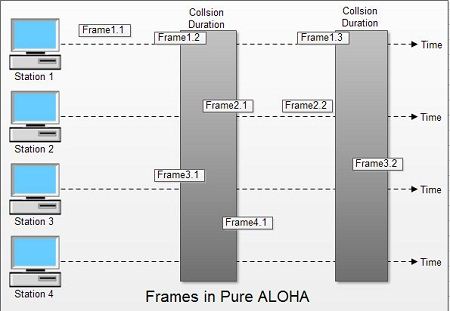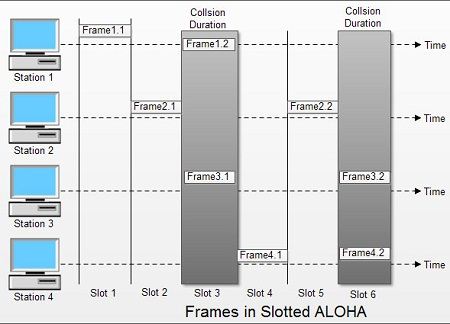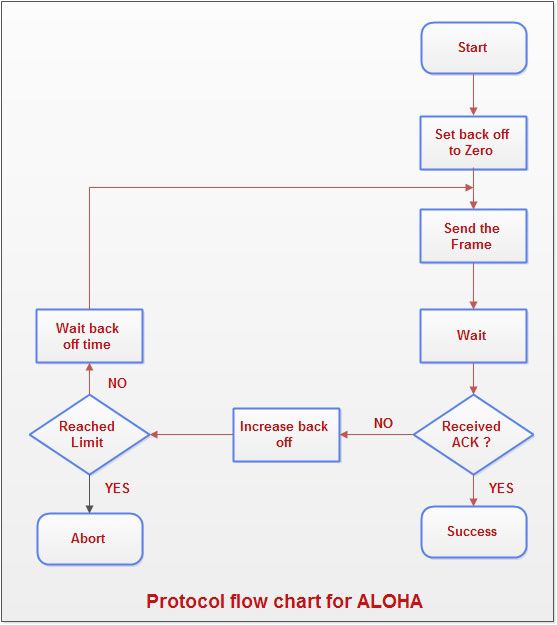ALOHA: ALOHA is a system for coordinating and arbitrating access to a shared communication Networks channel. It was developed in the 1970s by Norman Abramson and his colleagues at the University of Hawaii. The original system used for ground based radio broadcasting, but the system has been implemented in satellite communication systems.
A shared communication system like ALOHA requires a method of handling collisions that occur when two or more systems attempt to transmit on the channel at the same time. In the ALOHA system, a node transmits whenever data is available to send. If another node transmits at the same time, a collision occurs, and the frames that were transmitted are lost. However, a node can listen to broadcasts on the medium, even its own, and determine whether the frames were transmitted.
Aloha means “Hello”. Aloha is a multiple access protocol at the data-link layer and proposes how multiple terminals access the medium without interference or collision. In 1972 Roberts developed a protocol that would increase the capacity of aloha two fold. The Slotted Aloha protocol involves dividing the time interval into discrete slots and each slot interval corresponds to the time period of one frame. This method requires synchronization between the sending nodes to prevent collisions.
We’ll be covering the following topics in this tutorial:
There are two different versions of ALOHA

Pure ALOHA
• In pure ALOHA, the stations transmit frames whenever they have data to send.
• When two or more stations transmit simultaneously, there is collision and the frames are destroyed.
• In pure ALOHA, whenever any station transmits a frame, it expects the acknowledgement from the receiver.
• If acknowledgement is not received within specified time, the station assumes that the frame (or acknowledgement) has been destroyed.
• If the frame is destroyed because of collision the station waits for a random amount of time and sends it again. This waiting time must be random otherwise same frames will collide again and again.
• Therefore pure ALOHA dictates that when time-out period passes, each station must wait for a random amount of time before re-sending its frame. This randomness will help avoid more collisions.
• Figure shows an example of frame collisions in pure ALOHA.

• In fig there are four stations that .contended with one another for access to shared channel. All these stations are transmitting frames. Some of these frames collide because multiple frames are in contention for the shared channel. Only two frames, frame 1.1 and frame 2.2 survive. All other frames are destroyed.
• Whenever two frames try to occupy the channel at the same time, there will be a collision and both will be damaged. If first bit of a new frame overlaps with just the last bit of a frame almost finished, both frames will be totally destroyed and both will have to be retransmitted.
Slotted ALOHA
• Slotted ALOHA was invented to improve the efficiency of pure ALOHA as chances of collision in pure ALOHA are very high.
• In slotted ALOHA, the time of the shared channel is divided into discrete intervals called slots.
• The stations can send a frame only at the beginning of the slot and only one frame is sent in each slot.

• In slotted ALOHA, if any station is not able to place the frame onto the channel at the beginning of the slot i.e. it misses the time slot then the station has to wait until the beginning of the next time slot.
• In slotted ALOHA, there is still a possibility of collision if two stations try to send at the beginning of the same time slot as shown in fig.
• Slotted ALOHA still has an edge over pure ALOHA as chances of collision are reduced to one-half.
Protocol Flow Chart for ALOHA
Fig. shows the protocol flow chart for ALOHA.

Explanation:
• A station which has a frame ready will send it.
• Then it waits for some time.
• If it receives the acknowledgement then the transmission is successful.
• Otherwise the station uses a backoff strategy, and sends the packet again.
• After many times if there is no acknowledgement then the station aborts the idea of transmission.
 Dinesh Thakur holds an B.C.A, MCDBA, MCSD certifications. Dinesh authors the hugely popular
Dinesh Thakur holds an B.C.A, MCDBA, MCSD certifications. Dinesh authors the hugely popular